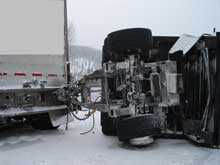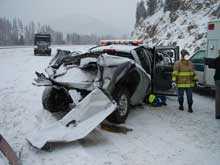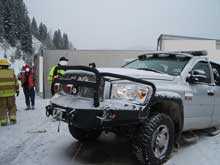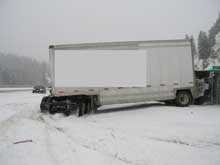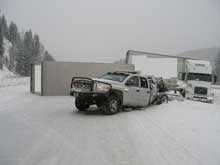Volunteer Fire Fighter Sitting in his Parked Vehicle Warning Oncoming Traffic of a Motor Vehicle Incident was Struck and Killed by a Tractor-Trailer- Montana
 Death in the Line of Duty...A summary of a NIOSH fire fighter fatality investigation
Death in the Line of Duty...A summary of a NIOSH fire fighter fatality investigation
F2009-03 Date Released: April 9, 2009
SUMMARY
On December 17, 2008, a 59-year-old male volunteer fire fighter (the victim) was fatally injured when a tractor-trailer struck his parked privately owned vehicle (POV). The victim had responded to a weather related single motor vehicle incident on an interstate highway. The vehicle was traveling eastbound when the driver lost control, drove through the median into the westbound lanes, and rolled over onto the north shoulder of the westbound lanes. Upon his arrival to the scene, the incident commander (IC) advised the victim to position his pick-up truck upstream to warn oncoming traffic of the vehicle incident in the curve. He positioned himself upstream on the north shoulder of the westbound lanes and turned on his emergency flashers and roof-top light bar. The oncoming tractor, pulling two trailers, lost control when changing lanes causing the rear trailer to swing counter-clockwise. The operator swerved several times before the rear trailer struck the victim's pick-up truck that was positioned on the north shoulder. The victim was not ejected from the vehicle and was found laying on the rear set of seats without his seat belt on. He was pronounced dead at the scene. Key contributing factors identified in this investigation include hazardous road conditions, the speed of the tractor-trailer, and nonuse of a seat belt by the fire fighter.
 |
NIOSH investigators concluded that, in order to minimize the risk of similar occurrences, companies using tractor-trailers should:
- ensure that operators drive in a manner that is compatible with weather conditions
NIOSH investigators also recommend that:
- fire departments and fire service consensus standard committees consider reevaluating current standards on seat belt use to include their use while vehicles are parked and occupied at highway incidents
Although there is no evidence that the following recommendation could have specifically prevented this fatality, NIOSH investigators recommend that:
- fire departments should reevaluate current policies and procedures to ensure that temporary traffic control devices are available and deployed upstream of warning vehicles
INTRODUCTION
On December 17, 2008, a 59-year-old male volunteer fire fighter (the victim) was fatally injured when a tractor-trailer struck his parked POV. On December 19, 2008, the U.S. Fire Administration (USFA) notified the National Institute for Occupational Safety and Health (NIOSH) of this incident. On January 5-9, 2009, a Safety and Occupational Health Specialist from the NIOSH Fire Fighter Fatality Investigation and Prevention Program traveled to Montana to investigate this incident. The NIOSH investigator met with the fire chief of the victim's department, the state highway patrol sergeant and crash investigator, county sheriff/coroner, county attorney, fire and emergency medical services (EMS) responders, and a state fire service training manager. The investigator reviewed the victim's training records and witness statements, visited the incident site and took photographs. The investigator also reviewed the 911 dispatch logs, preliminary Montana State Highway Patrol Crash Report findings, Montana Highway Patrol Division Code, commercial driver's license (CDL) requirements, law enforcement investigation photographs, and fire department photographs.
FIRE DEPARTMENT
This volunteer fire department has two stations with 22 volunteer members that serve a population of approximately 850 within an area of about 350 square miles. The department has three engines, a brush truck, crash truck, and quick response unit (QRU).
TRAINING and EXPERIENCE
The victim had served 15 years as a volunteer with this fire department. The victim had completed online training for the incident command system (ICS) at levels 100, 200, 700, and 800. The victim had also received highway incident safety training from the department’s insurance carrier in 2007. He was also designated as the department’s safety officer.
The assistant fire chief of the victim's department established himself as the IC during the incident. He has been a volunteer with this department for 5 years and received the same training as the victim.
The fire department has written guidelines regarding the use of crash scene clothing, personal protective equipment (PPE), and proper vehicle blocking. These guidelines focus on when to wear crash scene reflective gear, potential hazards encountered, and how to establish a safety zone and vehicle block for oncoming traffic.
EQUIPMENT and PERSONNEL
The victim was parked in his silver 2008 4x4 dual cab, one ton pick-up truck. The victim had purchased and placed optical warning devices on this vehicle. This included strobe lights in the head and tail light assemblies, alternating light-emitting-diode (LED) red and white grill lights (two of each), and a roof top light bar consisting of alternating LED red, white, and amber lights. All of these optical warning devices, including the vehicle's emergency flashers, were active during the incident. The victim's vehicle was also used by him while working with a local wrecker service.
According to law enforcement and the fire chief, the operator of the tractor-trailer stated he was able to see the victim's vehicle. The tractor had three axles and ten tires. The first and second trailer had a single mounted rear axle with four tires. The second trailer was resting on a dolly with a single axle and two tires (see Photo 1). The first trailer was attached to the tractor while the second trailer with dolly was hitched to the rear of the first trailer. The first trailer measured approximately 26 feet in length and the second trailer measured approximately 25 feet. It is not believed that the trailers were over weight at the time of the incident.
|
|
Photo 1. Dolly used to pull second trailer in tandem. |
TIMELINE
The timeline for this incident, in order of arrival time and key events, includes:
1110 hours County 911 dispatch center dispatches fire department for a “vehicle accident”
1114 hours QRU marks en route to the scene
1119 hours Truck 7 with the IC marks en route to the scene
1121 hours QRU marks arrived on scene
1125 hours Truck 7 marks arrived on scene
1126 hours Victim arrives on scene and is advised by the IC to warn traffic upstream
1148 hours Victim’s vehicle struck by tractor-trailer
PERSONAL PROTECTIVE EQUIPMENT
At the time of the incident, the victim was wearing his department issued bunker pants and other weather related garments. He had been issued an ANSI/ISEA 107-2004 Class III garment that was found in the back seat of his pick-up truck with a garment bag containing other highway safety items.
WEATHER and ROAD CONDITIONS
The temperature was 5°F, steady snow and visibility in excess of half a mile. According to the highway patrol, a layer of ice covered the highway, but was not slick due to snow and sand mixed over this layer. This four lane interstate highway traveled west and east through varying elevations and mountain canyons. The westbound travel lanes consisted of two 12 foot lanes, a paved 10 foot wide north shoulder, and paved 4 foot south shoulder. The area where this incident occurred was straight with a .7%-1.2% uphill grade westbound. The posted speed limit was 75 miles per hour (mph) for personal vehicles and 65 mph for trucks. The state highway patrol crash investigator estimated the tractor-trailer speed to be too fast for the highway conditions.
INVESTIGATION
On December 17, 2008, at 1148 hours, the victim lost his life while sitting in his parked pick-up truck. The victim had responded to a single vehicle incident located on the shoulder of a major interstate highway. Upon his arrival to the scene at 1126 hours, the IC asked him to position his POV upstream and warn oncoming traffic of the vehicle incident. Cones and an apparatus block had already been established for this incident. The victim drove west past the incident taking the nearest exit to turn around and head east. He positioned his vehicle upstream on the right, westbound north shoulder approximately 750 feet before the incident (see Diagram 1). The IC did not tell him where to position himself, but he felt that the victim wanted to position himself well upstream of the curve so that he could warn motorists of the vehicle incident. The stretch of highway before the curve had a slight grade and was straight, but the vehicle incident in the turn was not visible to oncoming traffic. Note: It was estimated by fire department personnel that oncoming traffic could have seen the vehicle incident when entering the curve, approximately 600 feet before.
The victim's pick-up truck was positioned at an angle on the north shoulder of the westbound lanes. State Highway Patrol investigators could not determine the exact angle, but it was determined that the vehicle was not in the right travel lane. The vehicle was placed in park with the motor running. It was never determined if the victim had exited the vehicle to flag and warn traffic prior to the incident, but the victim was found not wearing his ANSI/ISEA 107-2004 Class III garment after the fatal incident. The pick-up truck's optical warning lights were all on (see Photo 2).
|
|
Photo 2. Placement and use of optical warning |
The operator of an approaching tractor pulling two trailers lost control approximately three-tenths of a mile before the victim's position (estimated by State Highway Patrol). The operator advised the crash investigator he was attempting to change lanes while down shifting after he saw the emergency lights on the victim's vehicle. While doing so, the second trailer attached to the first became unstable and started to fishtail. The crash investigator stated that the tractor-trailer went back and forth across both westbound travel lanes. He believes that the right rear of the first trailer impacted the victim's pick-up truck first, and then the dolly and second trailer swung around impacting the pick-up truck and jack-knifing.
The victim's pick-up truck was pushed approximately 150 feet west of its original position coming to rest in the left travel lane. The tractor-trailer continued in the same direction coming to rest in the median in a snow bank (see Photo 3).
|
|
Photo 3. From left to right, downstream and |
The victim was found unrestrained and not seated in the driver seat. He was found with his legs draped over the driver seat, torso laying on the rear row of seats, body facing supine, and pointed towards the passenger side rear door. The driver seat was positioned beyond a 90° angle. It was not determined whether it was broken or reclined. The State Highway Patrol investigator confirmed that the column shifter was placed in park and observed that the icon to "put your seat belt on" was illuminated on the instrument panel after the incident. The parking brake was also set. It is believed that the victim was ejected from the driver seat and suffered fatal injuries after striking the interior of the vehicle. Crash investigators found transfer of the victim's hair from impacting the headliner in the area of the driver side C-pillar. There was little damage to the vehicle's interior passenger compartment between the A- and B-pillars (see Photo 4), and it appears that the space for the front seat occupants was preserved. All four doors on the vehicle were jammed requiring mechanical means to access the victim.
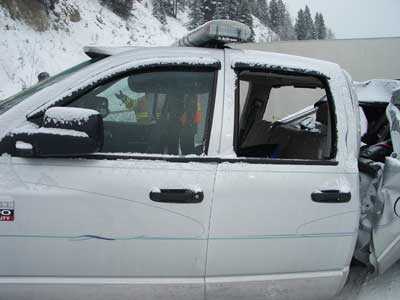 |
Photo 4. Showing virtually no damage |
The crash investigator stated the tractor-trailer was going too fast for the weather conditions encountered. The investigator also stated the operator had a current CDL issued from the state of New Jersey with double/triple trailer qualifications, the tractor and trailers were properly maintained with a working air-brake system, hitches were properly placed, secured and did not fail, and tires were found to have adequate air pressure and tread depth.
CONTRIBUTING FACTORS
Occupational injuries and fatalities are often the result of one or more contributing factors or key events in a larger sequence of events that ultimately result in the injury or fatality. NIOSH investigators identified the following items as key contributing factors in this incident that ultimately led to the fatality:
- Hazardous road conditions
- The speed of the tractor-trailer was too fast for road conditions
- The seat belt was not used to restrain the victim in his seated position
CAUSE OF DEATH
According to the coroner, the cause of death for the victim was multiple blunt force traumas.
RECOMMENDATIONS
Recommendation #1: Companies using tractor-trailers should ensure that operators drive in a manner that is compatible with weather conditions
Discussion: According to the Federal Motor Carrier Safety Administration (FMCSA) Large Truck Causation Study, "traveling too fast for conditions" was the single most frequently cited factor in large truck crashes. 1 The FMCSA oversees the safety of commercial vehicles in interstate commerce (vehicles operating across state lines). FMCSA regulations cover equipment, licensing, hours of service, and vehicle inspection and maintenance, and state inspectors are the primary enforcers of the federal rules for equipment, hours of service, and vehicle maintenance and inspection. 2 The Montana and New Jersey Commercial Driver License Manuals (CDLM) state driving too fast can require an operator to adjust speed to driving conditions (i.e. traction, curves, visibility, traffic and hills), consider stopping distances, and to the extent possible control skids.3,4 It may take longer to stop a vehicle when driving on slippery surfaces, requiring the driver to drive slower with caution. The CDLM for Montana and New Jersey states that speeds on packed snow should be one-half the posted speed limit, and if the roads are icy, speeds should be reduced to a crawl until the driver can safely remove the vehicle from the roadway. Stopping distances can be affected by the weight of the tractor and trailer(s), road surface, and terrain.
A special focus for commercial truck drivers should be maintaining control during a skid. A skid is something that occurs when tires lose road grip, and in the case of tractor-trailers, can lead to jack-knife incidents. This can occur from over-braking, over-steering, over-acceleration, or driving too fast. According to the Montana and New Jersey CDLM the most common skid is one in which the rear wheels lose traction through excessive braking or acceleration; acceleration skids usually occur on ice or snow. 3,4
Multiple trailers in tow are less stable than other commercial vehicles. 2-4 Operators need to drive slow and gently through turns and be aware of adverse conditions (i.e. weather, slippery conditions, or terrain). Multiple trailers in tow increase vehicle length, giving the operator more dead axles to pull, thus increasing chances for skids and loss of traction during these adverse conditions. 3,4
Operators pulling conventional double trailers should be cognizant of what is called "crack-the-whip" effect. "When the wheels of a trailer lock up, the trailer will tend to swing around. This is more likely to happen when the trailer is empty or lightly loaded. This type of jack-knife is often called a 'trailer jack-knife.' The earliest and best way to recognize that the trailer has started to skid is by seeing it in your mirrors. Any time you apply the brakes hard; check the mirrors to make sure the trailer is staying where it should be. Once the trailer swings out of your lane, it's very difficult to prevent a jack-knife." 1
During this incident, it was determined by the state highway patrol that the operator of the tractor-trailer was going too fast for highway conditions. The operator, heading west in the right lane, reported seeing the victim's vehicle on the right shoulder alerting him to move over to the left lane. The state of Montana has a "Move Over" law. When doing so, the second trailer started to skid and swing around. The second trailer ultimately struck the victim's pick-up truck.
The American Trucking Associations (ATA) and the public safety interest group, Road Safe America, filed a petition that is currently under review by the FMCSA and National Highway Traffic Safety Administration (NHTSA) to require speed governors be electronically placed on large trucks weighing over 26,000 pounds.1 If approved, this will limit their maximum safe speed to 68 miles per hour in hopes of reducing the number and severity of crashes involving large trucks.
NIOSH investigators also recommend that:
Recommendation #2: Fire department and fire service consensus committees should consider reevaluating current standards on seat belt use to include their use while vehicles are parked and occupied at highway incidents
Discussion: NFPA 1500 states, "all persons riding in fire apparatus shall be seated and belted securely by seat belts in approved riding positions at any time the vehicle is in motion; where members are authorized to respond to incidents or to fire stations in private vehicles, the fire department shall establish specific rules, regulations, and procedures relating to the operation of private vehicles in an emergency mode; these rules and regulations shall be at least equal to the provisions regulating the operation of fire department vehicles."5 The fire department had a standard operating procedure (SOP) that required the use of seat belts by fire department members. However, NFPA 1500 and the fire department SOP do not address the need for fire fighters to be properly restrained in a vehicle when parked and performing such tasks as staging, blocking, or warning traffic at highway incidents. The U.S. Fire Administration's Traffic Incident Management Systems states, "often firefighters may simply be sitting in vehicles that are parked for the purpose of blocking at roadway emergency scenes; if the fire apparatus is struck by a vehicle approaching the incident scene, unsecured firefighters could sustain serious injuries or be killed in that collision."6 Seat belts are the single most effective means of reducing deaths and serious injuries in traffic crashes.7
Currently, motor vehicles are equipped with occupant protection devices that include seat belts, air bags, specially designed seat geometry and head rests, and vehicle structures that collapse systematically in a crash to dissipate crash energy and preserve the occupant space. Correct use and functioning of all components of the system are necessary to provide the intended crash protection for the occupant. A seat belt restrains an occupant in their seat to reduce injury from contact between the occupant and vehicle interior and the risk of being thrown from a vehicle. In the case of rear-end collisions such as in this incident, much of the protection afforded the occupant is derived from the seatback and head rest and it is critical to restrain the occupant in the correct seat position to realize this protection.8 Once the occupant is dislodged from the seat, not only are they subject to injury from secondary collisions with objects and surfaces of the passenger compartment, but protection afforded by the seat is lost.
During this incident, the victim drove his POV to the scene. After positioning his POV on the shoulder, it was struck from the rear by a tractor-trailer. The victim was not wearing his seat belt at the time of impact. Although it cannot be conclusively determined that the victim would not have received crash-related injuries had he been restrained in the driver's seat, evidence suggests that correct seatbelt use may have significantly minimized these injuries.8
Although there is no evidence to suggest that the following recommendation could have specifically prevented this fatality, NIOSH investigators recommend that:
Recommendation #3: Fire departments should reevaluate current policies and procedures to ensure that temporary traffic control devices are available and deployed upstream of warning vehicles
Discussion: The Manual on Uniform Traffic Control Devices (MUTCD) defines a temporary traffic control (TTC) zone as: "an area of a highway where road user conditions are changed because of a work zone or an incident through the use of TTC devices, uniformed law enforcement officers, or other authorized personnel. An incident area is an area of a highway where temporary traffic controls are imposed by authorized officials in response to a traffic incident, natural disaster, or special event. It extends from the first warning device (such as a sign, light, or cone) to the last TTC device or to a point where road users return to the original lane alignment and are clear of the incident."9 The primary function of the TTC is to provide for reasonably safe and effective movement of road users through or around the work area, while providing a reasonable level of protection to the responders operat¬ing on the scene.6 The fire department had established SOPs for temporary traffic control. The fire department routinely dispatched an extra fire apparatus to block; used cones, emergency road signs, and flares; issued high visibility retroreflective garments to its members; and, a policy allowing its members to outfit their POVs with emergency lights. The use of adjunct warning lights or audible devices on private vehicles while responding to, or operating at, emergency scenes is a common practice in many jurisdictions, particularly those with volunteer firefighters or fire police. Several issues with respect to the safe use of these devices warrant attention including how to ensure: (1) operator competency, including familiarity with the scope of legal authority to use such devices; (2) adequate vehicle visibility when such devices are deployed, and; (3) proper vehicle positioning when responding to, or operating, at emergency scenes.10
During this incident, cones and an apparatus block had been established for an incident on the right shoulder in a curve. Emergency signs had not been placed. The incident was minor and in the wrap up stages. The victim would usually respond to the scene of highway incidents to assist in the set-up of the temporary traffic control. When not needed at the scene the victim would position his vehicle upstream from the incident to warn oncoming traffic of the downstream traffic control zone. This was very important during this incident because a motorist could not see the incident on the straightaway before the curve. The temporary traffic control zone was established 100 feet before the incident and the victim positioned his vehicle 650 feet upstream from the first cone placed for the temporary traffic control zone. While operating in or around moving traffic one should never trust oncoming traffic or turn their backs to it.11 The victim did not exit the vehicle, leaving his back turned to oncoming traffic. The victim also did not have emergency road signs, cones, or flagging equipment in his vehicle. Even though these temporary traffic control devices were not used by the victim, the operator of the tractor-trailer stated that the victim's vehicle and optical emergency warning lights were visible while parked on the right shoulder. During the process of the tractor-trailer moving over, the chain of events began ultimately taking the life of the victim.
REFERENCES
- CDC [2008]. CDC Features: sharing the road - large trucks and road safety. Atlanta, GA: Centers for Disease Control. http://www.cdc.gov/Features/LargeTruckSafety/. Accessed 2/19/09.
- IIHS [2008]. Q&As: large trucks. Arlington, VA: Insurance Institute for Highway Safety, Highway Loss Data Institute. http://www.iihs.org/iihs/topics/t/large-trucks/qanda#large-trucks. Accessed 2/19/2009. (Link Updated 10/28/2013)
- Montana Department of Justice [2008]. Montana commercial driver license manual. Helena, MT: Department of Justice, Motor Vehicle Division, Field Operations Bureau. https://doj.mt.gov/wp-content/uploads/25-0300.pdf. Accessed 1/16/2009. (Link Updated 1/15/2013)
- New Jersey Motor Vehicle Commission [2007]. New Jersey commercial driver license manual: requirements for licensing in New Jersey. West Trenton, NJ: New Jersey Motor Vehicle Commission. http://www.nj.gov/mvc/pdf/Commercial/CDL_Manual_english.pdf. Accessed 2/13/2009.
- NFPA [2007]: NFPA 1500: Standard on fire department occupational safety and health program. Quincy, MA: National Fire Protection Association.
- United States Fire Administration [2008]. Traffic incident management systems. United States Fire Administration website: http://www.usfa.fema.gov/media/press/2008releases/052108.shtm. Accessed 1/21/2009. (Link Updated 1/17/2013)
- Occupational Safety and Health Administration [2006]. Guidelines for employers to reduce motor vehicle crashes. OSHA website: https://www.osha.gov/Publications/motor_vehicle_guide.html. Accessed 1/20/2009.
- Viano DC [2002]. Role of the seat in rear crash safety. Society of Automotive Engineers, Inc. Warrendale, PA.
- FHWA [2008]. Manual on uniform traffic control devices. Washington, DC: U.S. Department of Transportation, Federal Highway Administration (FHWA). http://mutcd.fhwa.dot.gov/pdfs/2003r1r2/mutcd2003r1r2complet.pdf.
- Cumberland Valley Volunteer Firemen's Association [1999]. A White Paper: protecting emergency responders on the highways. Responder Safety Website: http://www.respondersafety.com/DownloadCategories/White_Papers.aspx. Accessed 2/21/2009. (Link updated 4/9/2013)
- University of Extrication "Safe Parking" SOP: safe positioning while operating in or near moving traffic. Responder Safety website: http://www.respondersafety.com/DownloadCategories/SOPs_SOGs.aspx. Accessed 1/21/2009. (Link updated 4/9/2013)
INVESTIGATOR INFORMATION
This incident was investigated by Stacy C. Wertman, Safety and Occupational Health Specialist, with the Fire Fighter Fatality Investigation and Prevention Program, Surveillance and Field Investigations Branch, Division of Safety Research, NIOSH located in Morgantown, WV. A technical review was provided by Steve Austin from the Cumberland Valley Volunteer Firemen's Association and Emergency Responder Safety Institute.
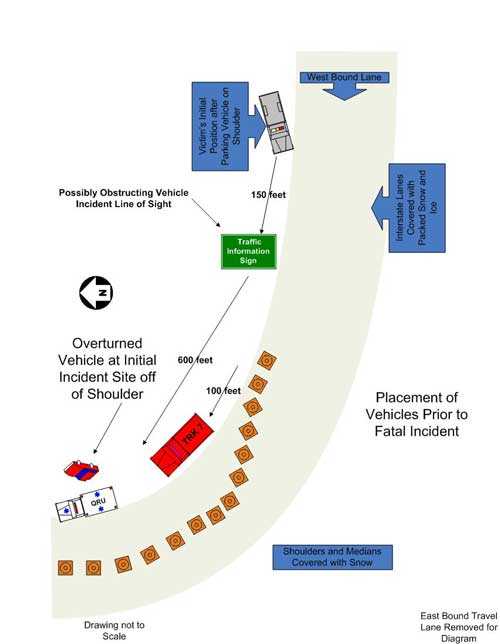 |
|
Diagram 1. Temporary traffic control prior to victim’s fatal incident. |
|
The National Institute for Occupational Safety and Health (NIOSH), an institute within the Centers for Disease Control and Prevention (CDC), is the federal agency responsible for conducting research and making recommendations for the prevention of work-related injury and illness. In fiscal year 1998, the Congress appropriated funds to NIOSH to conduct a fire fighter initiative. NIOSH initiated the Fire Fighter Fatality Investigation and Prevention Program to examine deaths of fire fighters in the line of duty so that fire departments, fire fighters, fire service organizations, safety experts and researchers could learn from these incidents. The primary goal of these investigations is for NIOSH to make recommendations to prevent similar occurrences. These NIOSH investigations are intended to reduce or prevent future fire fighter deaths and are completely separate from the rulemaking, enforcement and inspection activities of any other federal or state agency. Under its program, NIOSH investigators interview persons with knowledge of the incident and review available records to develop a description of the conditions and circumstances leading to the deaths in order to provide a context for the agency's recommendations. The NIOSH summary of these conditions and circumstances in its reports is not intended as a legal statement of facts. This summary, as well as the conclusions and recommendations made by NIOSH, should not be used for the purpose of litigation or the adjudication of any claim. For further information, visit
the program website at www.cdc.gov/niosh/fire or call toll free 1-800-CDC-INFO (1-800-232-4636).
|
This page was last updated on 04/03/09.
- Page last reviewed: November 18, 2015
- Page last updated: October 15, 2014
- Content source:
- National Institute for Occupational Safety and Health Division of Safety Research


 ShareCompartir
ShareCompartir
